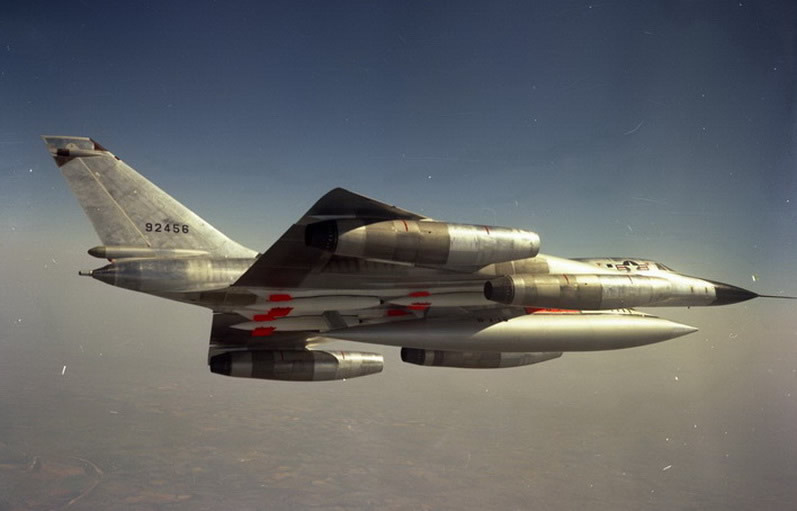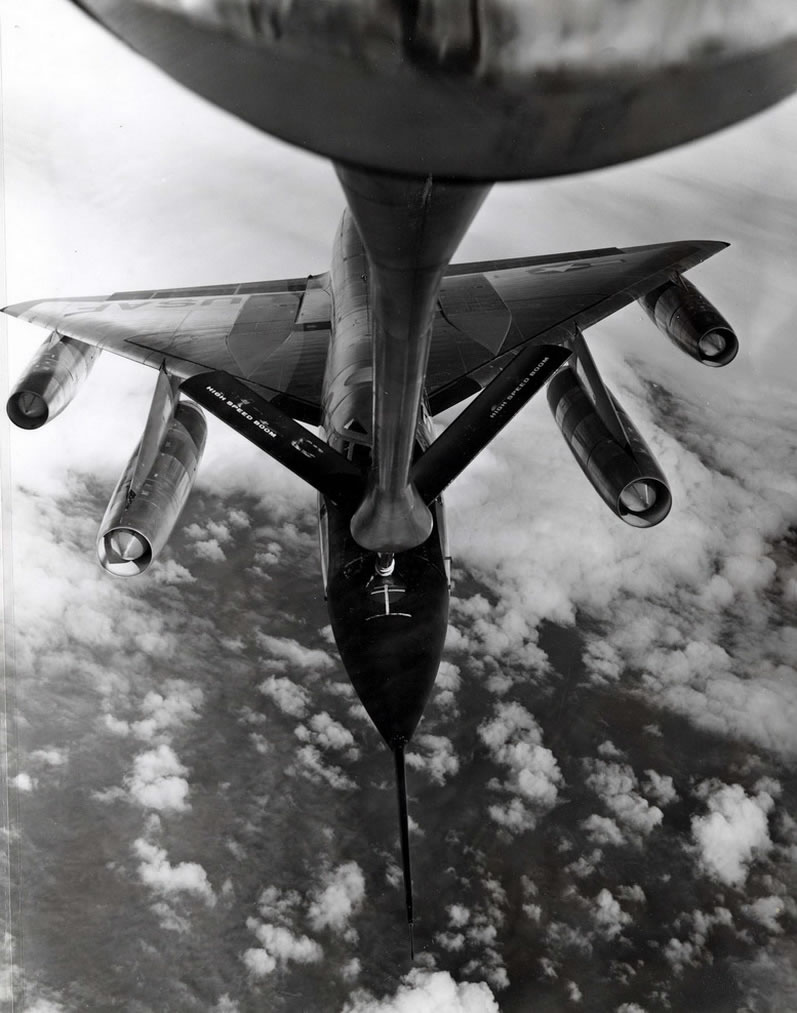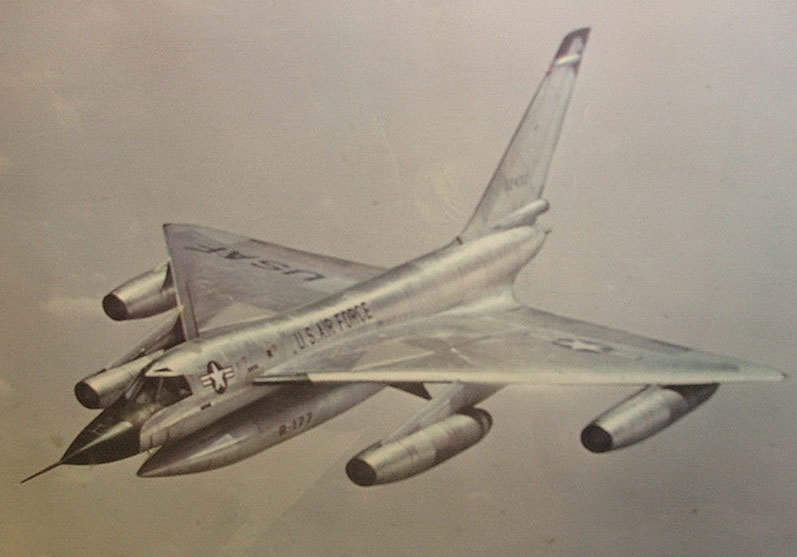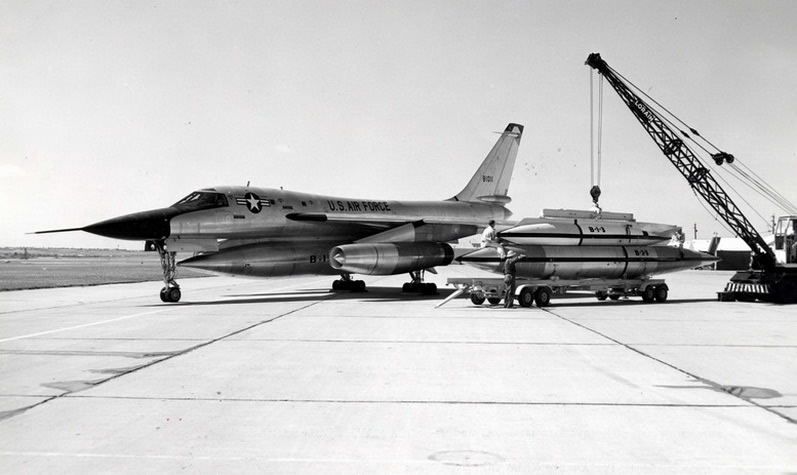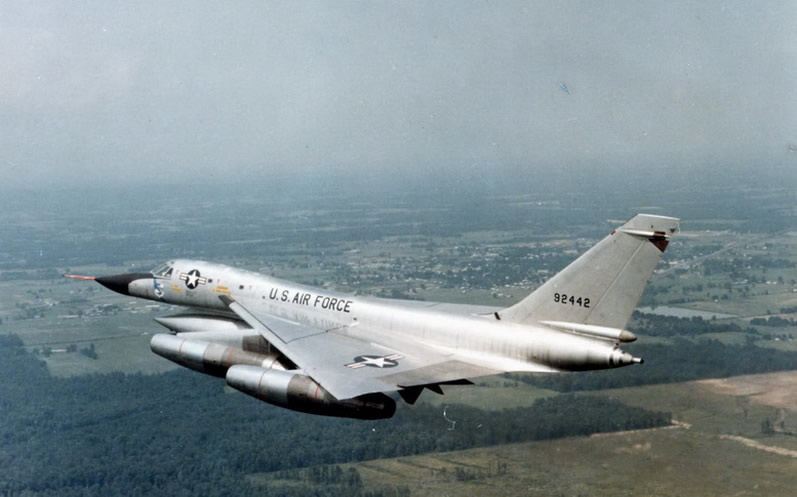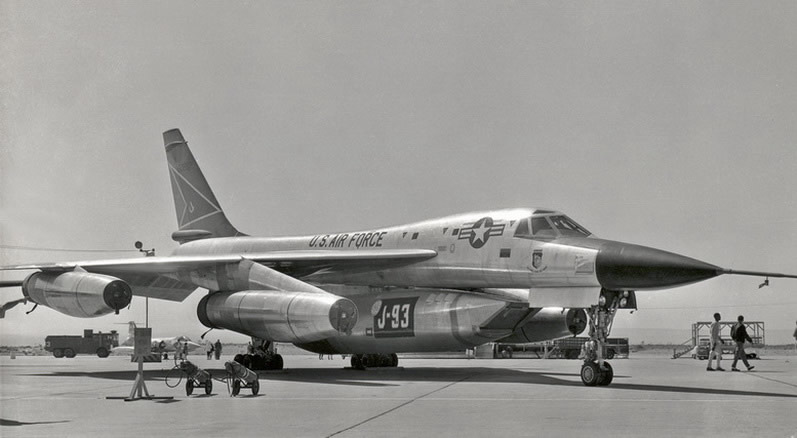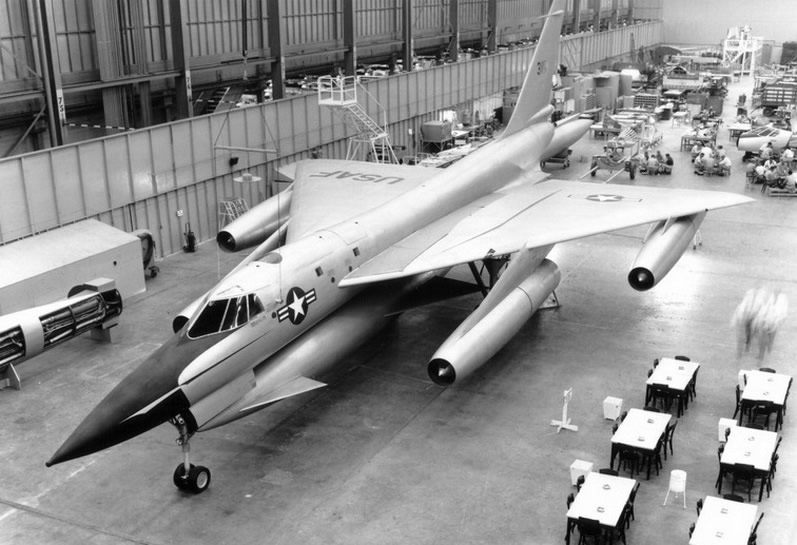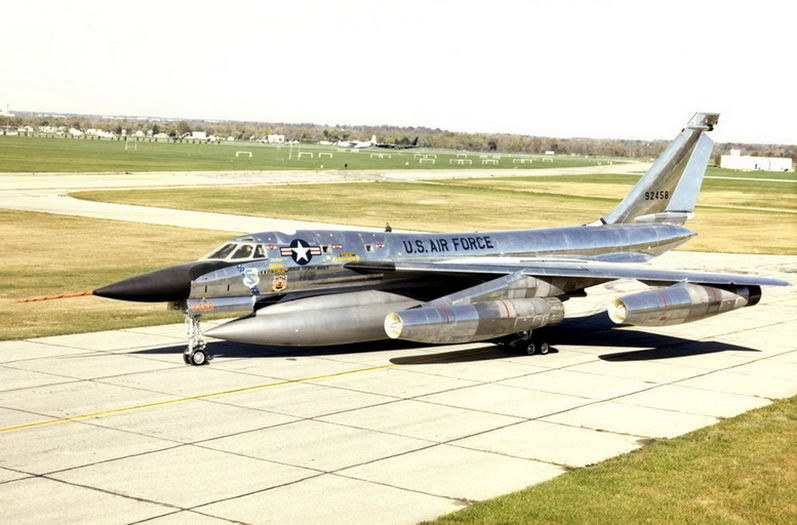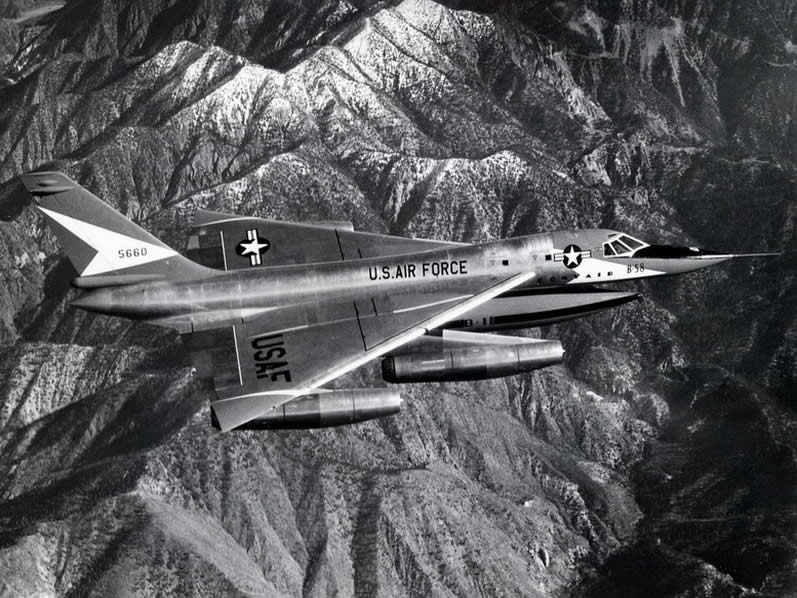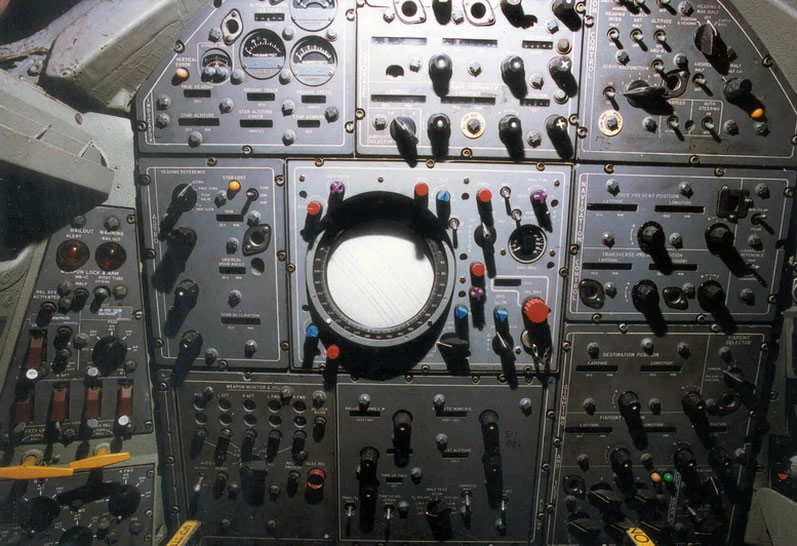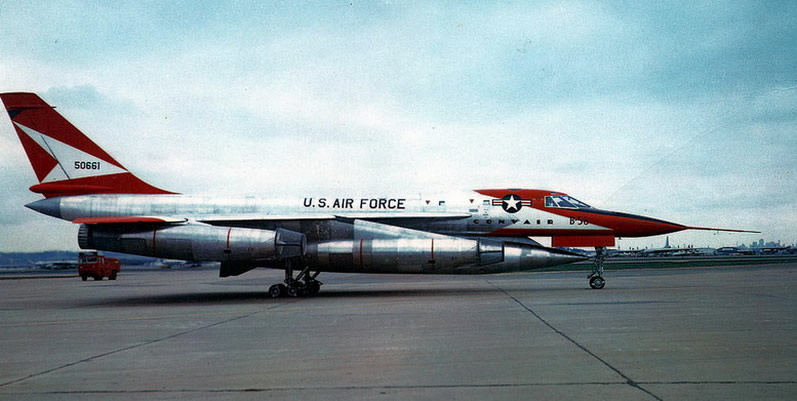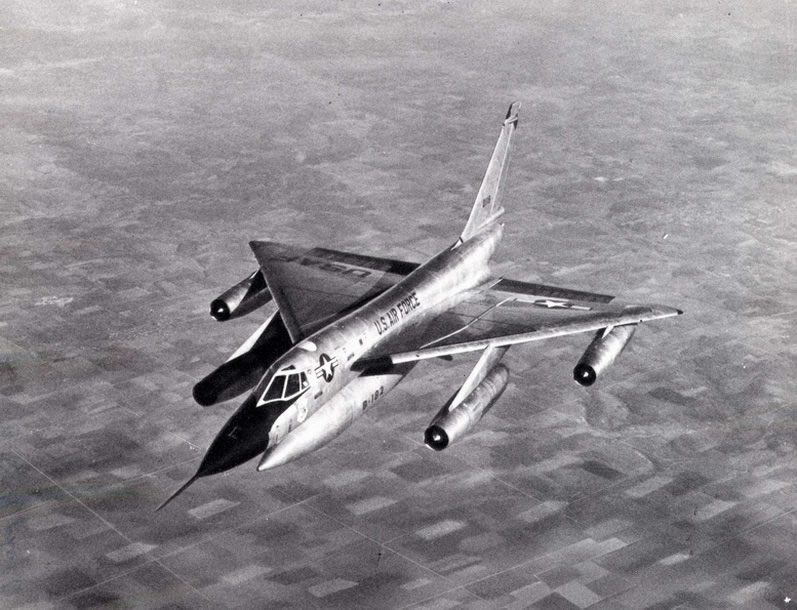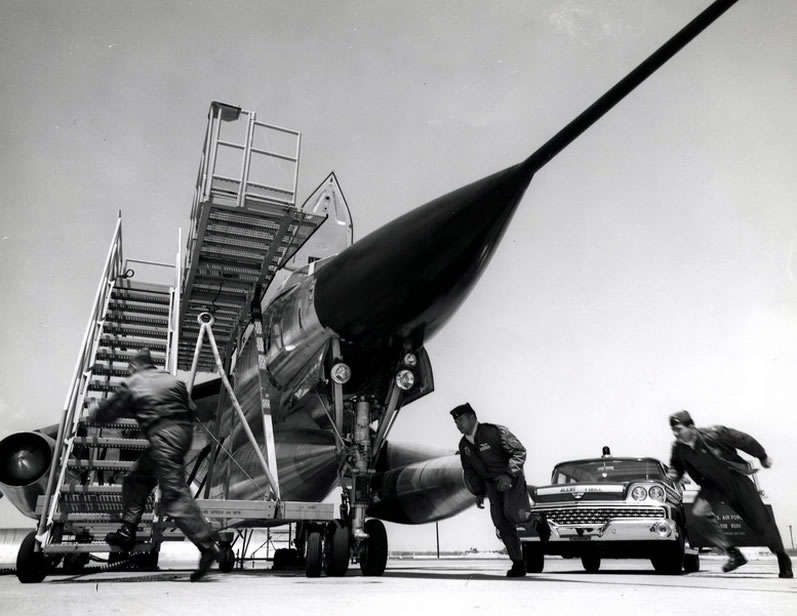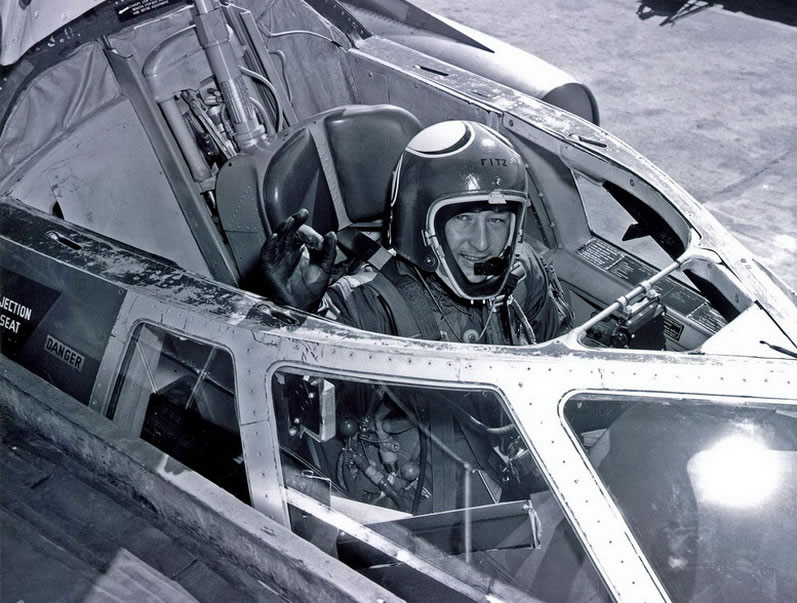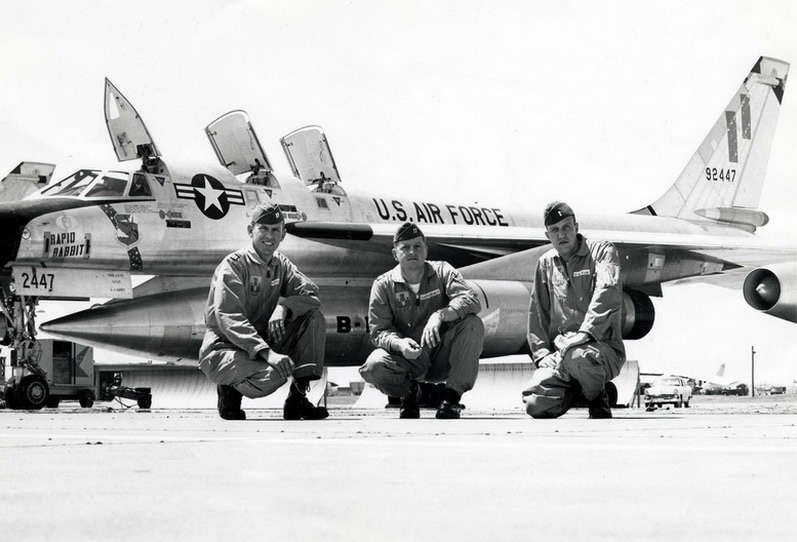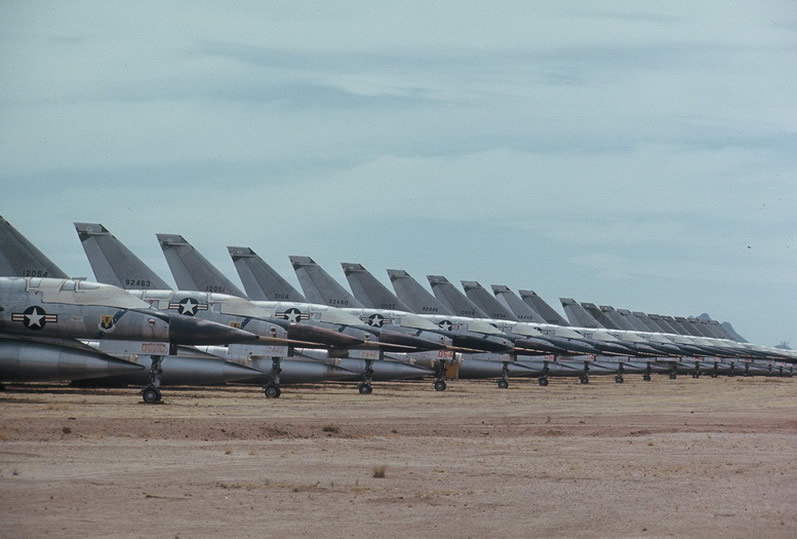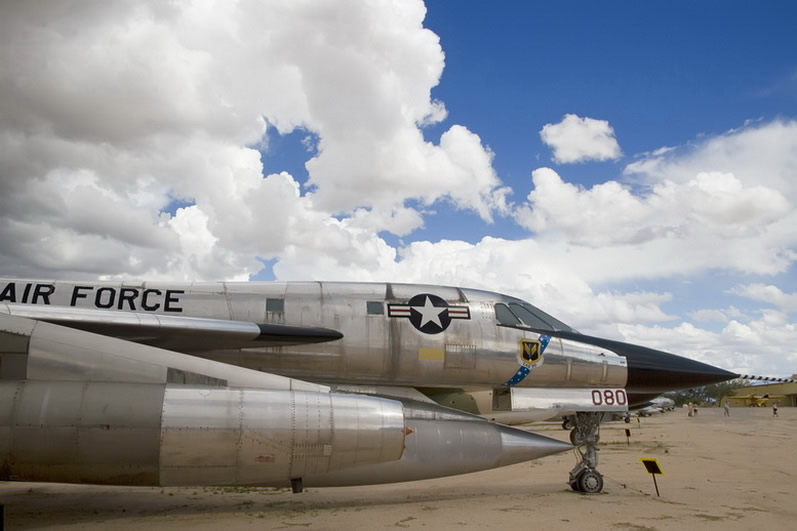B-58 "HUSTLER" USAF BOMBER AIRCRAFT HISTORY
INFORMATION PICTURES AND FACTS
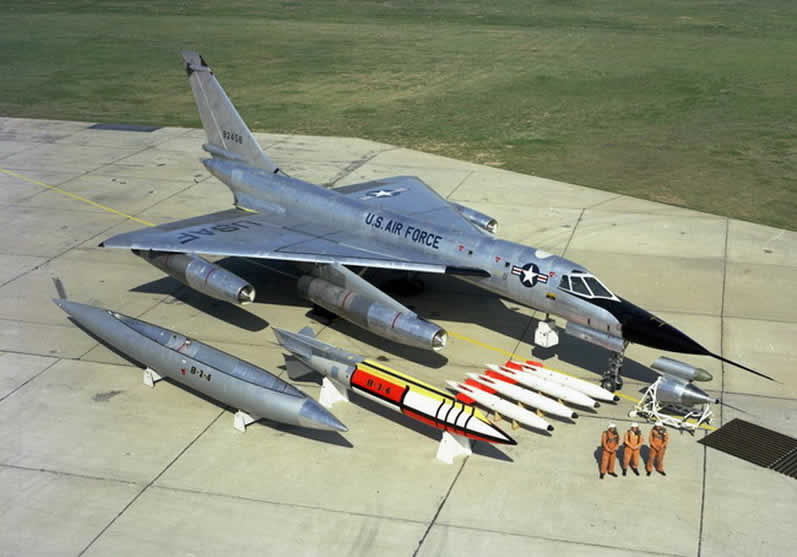 |
B-58 "HUSTLER" Bomber with pilots and bomb load
The Convair B-58 Hustler was the first operational supersonic jet bomber capable of Mach 2 flight.
The aircraft was designed by Convair engineer Robert H. Widmer and developed for the United States Air Force for service in the Strategic Air Command (SAC) during the 1960s. It used a delta wing, which was also employed by Convair fighters such as the F-102, with four J79 engines in pods under the wing. It carried a nuclear weapon and fuel in a large pod under the fuselage rather than in an internal bomb bay.
Replacing the B-47 medium bomber, it was originally intended to fly at high altitudes and supersonic speeds to avoid Soviet fighters. The B-58 received a great deal of notoriety due to its sonic boom, which was often heard by the public as it passed overhead in supersonic flight. The introduction of highly accurate Soviet surface-to-air missiles forced the B-58 into a low-level penetration role that severely limited its range and strategic value, and it was never employed to deliver conventional bombs. This led to a brief operational career between 1960 and 1969, when the B-58 was succeeded by the smaller, swing-wing FB-111A.
B-58 Hustler Design And DevelopmentThe genesis of the B-58 program came in February 1949, when a Generalized Bomber Study (GEBO II) had been issued by the Air Research and Development Command (ARDC) at Wright-Patterson AFB, Ohio. A number of contractors submitted bids including Boeing, Convair, Curtiss, Douglas, Martin and North American Aviation.
Building on Convair's experience of earlier delta-wing fighters, beginning with the XF-92A, a series of GEBO II designs were developed, initially studying swept and semi-delta configurations, but settling on the delta wing planform. The final Convair proposal, coded FZP-110, was a radical two-place, delta wing bomber design powered by General Electric J53 engines. The performance estimates included a 1,000 mph (1,600 km/h; 870 kt) speed and a 3,000 statute mile (4,800 km; 2,600 nmi) range.
The USAF chose Boeing (MX-1712) and Convair to proceed to a Phase 1 study. The Convair MX-1626 evolved further into a more refined proposal redesignated the MX-1964. In December 1952, the Air Force selected the MX-1964 as the winner of the design competition to meet the newly proposed SAB-51 (Supersonic Aircraft Bomber) and SAR-51 (Supersonic Aircraft Reconnaissance), the first General Operational Requirement (GOR) worldwide for supersonic bombers. In February 1953, the Air Force issued a contract for development of Convair's design.
The resulting B-58 design was the first "true" USAF supersonic bomber program. The Convair design was based on a delta wing with a leading-edge sweep of 60° with four General Electric J79-GE-1 turbojet engines, capable of flying at twice the speed of sound. Although its large wing made for relatively low wing loading, it proved to be surprisingly well suited for low-altitude, high-speed flight. It seated three (pilot, bombardier/navigator, and defensive systems operator) in separated tandem cockpits. Later versions gave each crew member a novel ejection capsule that made it possible to eject at an altitude of 70,000 ft (21,000 m) at speeds up to Mach 2 (1,320 mph/2,450 km/h). Unlike standard ejection seats of the period, a protective clamshell would enclose the seat and the control stick with an attached oxygen cylinder, allowing the pilot to continue to fly even "turtled up" and ready for immediate egress. The capsule would float, and the crewmember could open the clamshell, using it as a life raft. In an unusual test program, live bears and chimpanzees were successfully used to test the ejection system. The XB-70 would use a similar system (though using capsules of a different design).
Because of heat generated at Mach 2 cruise, not only the crew compartment, but the wheel wells and electronics bay were pressurized and air conditioned. The B-58 utilized one of the first extensive applications of aluminum honeycomb panels, which bonded outer and inner aluminum skins to a honeycomb of aluminum and fiberglass.
The pilot's cockpit was fairly conventional for a large multiengine aircraft. The electronic controls were ambitious and advanced for the day. The navigator and DSO's cockpits featured wrap around dashboards with warning lights and buttons, and automatic voice messages and warnings from a tape system were audible through the helmet sets. Research during the era of all-male combat aircraft assignments revealed that a woman's voice was more likely to gain the attention of young men in distracting situations. Nortronics Division of Northrop Corporation selected actress and singer Joan Elms to record the automated voice warnings. To the men flying the B-58, the voice was known as "Sexy Sally."
The Sperry AN/ASQ-42 bombing/navigation system combined sophisticated inertial navigation with the KS-39 astro-tracker to provide heading reference, the AN/APN-113 Doppler radar to provide ground velocity and windspeed data, a search radar to provide range data for bomb release and trajectory, and a radio altimeter. The AN/ASQ-42 was estimated to be 10 times more accurate than any previous bombing/navigation system.
Defensive armament consisted of a single 20 mm (0.79 in) T-171E-3 rotary cannon with 1,200 rounds of ammunition. It was remotely controlled by the DSO through the Emerson MD-7 fire control radar system. Offensive armament typically consisted of a single nuclear weapon, along with fuel tanks, in a streamlined MB-1C pod under the fuselage. Incurable difficulties with fuel leakage resulted in the replacement of the MB-1C with the TCP (Two Component Pod), which placed the nuclear weapon in an upper section while the lower fuel component could be independently jettisoned. This had the added benefit of allowing the pilot to "clean up" the aircraft for fuel efficiency or in case of emergency, while still retaining the more slim weapon.
The first prototype, serial number 55-660, was completed in late August 1956. The first flight took place in November 1956. A difficult and protracted flight test program involving 30 aircraft continued until April 1959. The final B-58 was delivered in October 1962. From 1961 to 1963, the B-58 was retrofitted with two tandem stub pylons under each wing root, adjacent to the centreline pod, for B43 or B61 nuclear weapons for a total of five nuclear weapons per aircraft. Although the USAF explored the possibility of using the B-58 for the conventional strike role, it was never equipped for carrying or dropping conventional bombs in service. A photo reconnaissance pod, the LA-331, was also fielded. Several other specialized pods for ECM or an early cruise missile were considered, but not adopted. The late 1950s WS-199C High Virgo air-launched ballistic missile was designed to be launched from the B-58 with four test launches of the High Virgo carried out by a B-58 to determine ballistic missile and anti-satellite system capability.
Operational History Of The B-58 HustlerThe B-58 crews were elite, hand-picked from other strategic bomber squadrons. Due to some characteristics of delta-winged aircraft, new pilots used the Convair F-102 Delta Dagger as a conversion trainer, before moving to the TB-58A trainer. The B-58 was difficult to fly and its three-man crews were constantly busy, but its performance was exceptional. A lightly loaded Hustler would climb at nearly 46,000 ft/min (235 m/s).
It had a much smaller weapons load and more limited range than the Boeing B-52 Stratofortress. The B-58 had been extremely expensive to acquire. Through FY 1961, the total cost of the B-58 program was $3 billion. It was a complex aircraft that required considerable maintenance, much of which required specialized equipment and ground personnel. The B-58 cost three times as much to operate as the B-52. This included special maintenance issues with the nose landing gear that retracted in a complicated fashion to avoid the center payload. It had an unfavorably high accident rate: 26 B-58 aircraft were lost in accidents, 22.4% of total production. It was very difficult to safely recover from the loss of an engine at supersonic cruise due to differential thrust. SAC had been dubious about the type from the beginning, although its crews eventually became enthusiastic about the aircraft; its performance and design were appreciated, although it was never easy to fly.
Two SAC bomb wings operated the B-58 during its operational service: the 43d Bombardment Wing, based at Carswell AFB, Texas from 1960 to 1964, and Little Rock AFB, Arkansas from 1964 to 1970; and the 305th Bombardment Wing, based at Bunker Hill AFB (later Grissom AFB), Indiana from 1961 to 1970. The 305th also operated the B-58 combat crew training school (CCTS), the predecessor of USAF's current formal training units (FTUs).
By the time the early problems had largely been resolved and SAC interest in the bomber had solidified, Secretary of Defense Robert McNamara decided that the B-58 was not going to be a viable weapon system. It was during the B-58's introduction that the surface-to-air missile (SAM) became a viable threat, especially the SA-2 Guideline, a SAM system the Soviet Union extensively deployed. The "solution" to this problem was to fly at low altitudes, minimizing the radar line-of-sight and minimizing exposure time.
Because of the denser air at low altitudes, the B-58 could not fly at supersonic speeds and its moderate range was reduced further, thereby negating the high performance the design paid so dearly for. In late 1965, Secretary McNamara ordered the B-58's retirement by 1970. Despite efforts of the Air Force to earn a reprieve, the phaseout proceeded on schedule. The last B-58s were retired in January 1970 and placed in storage in AMARC at Davis-Monthan Air Force Base. The fleet survived until 1977, when nearly all remaining aircraft were sold to Southwestern Alloys for disposal. The B-58 as a weapons system was replaced by the FB-111A, designed for low-altitude attack, and less expensive to produce. The Supply Squadron for the Division was manned by people who were the best in getting materials to keep the aircraft within flight status. The parts were so specialized that it could not be used in any other type of aircraft. The same part might be used on several aircraft when they were to sit on the ground for evaluation; the needed parts were removed to the aircraft that was to fly and was replaced after the flying aircraft ended its flying time and returned to the initial aircraft as it getting set to reenter to the flight status. A total of 116 B-58s were produced: 30 trial aircraft and 86 production B-58A models. Most of the trial aircraft were later upgraded to operational standard. Eight were equipped as TB-58A training aircraft. A number of B-58s were used for special trials, including testing the radar system intended for the Lockheed YF-12 interceptor. Several improved (and usually enlarged) variants, dubbed B-58B and B-58C by the manufacturer, were proposed but never built. Singer John Denver's father, Colonel Henry J. Deutschendorf, Sr., USAF, held several speed records as a B-58 pilot.
B-58 VariantsXB-58: Prototype. Two built.
|
© AviationExplorer.com - The Website For Aviation Enthusiasts |





